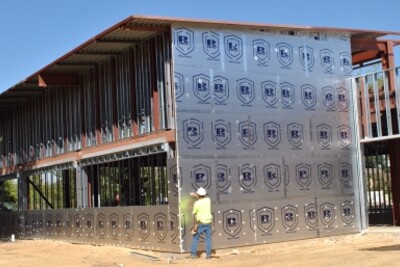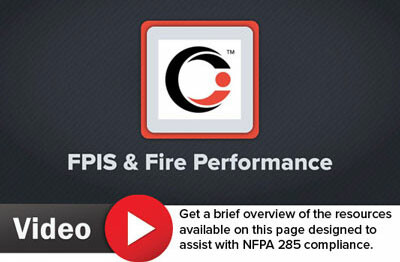
Foam plastic insulating sheathing products can be used in a variety of buildings and assemblies requiring fire resistance, where properly tested. Refer to these resources for using foam sheathing in fire rated applications.
Top Resources:
- Code Compliance Reports (available as sealed reports in 49 states):
- FPIS Products in Exterior Walls of Type I, II, III, and IV Buildings
- FPIS Products in Exterior Walls of Type V Buildings
- NFPA 285 Tested Assemblies Using FPIS Products
This report identifies the products supplied by FSC members who have code evaluation reports showing compliance with NFPA 285 testing requirements.
- North American Modern Building Alliance (NAMBA)
NAMBA focuses on addressing fire safety through the development and enforcement of building codes that rely on a clear understanding of the performance of plastic materials in building envelopes.- Guide: New Fire Safety Provisions in 2023 NFPA 285 and 2024 IBC
- Article: Where to Find Compliant NFPA 285 Test Data
- Resource: NFPA 285 Testing & Design Information (Part 1) - History & Roots
- Resource: NFPA 285 Testing & Design Information (Part 2) - More Than Just a Pass or Fail
- Resource: NFPA 285 Testing & Design Information (Part 3) - Designing for NFPA 285 Compliance
- Video: Using NFPA 285 for Fire Performance Tests of Exterior Wall Assemblies
- Webinar: Fire Safety for Exterior Wall Assemblies
Fire safety and moisture protection are crucial to the creation of a wall assembly that is durable, safe, and code compliant. This new addition to the FACTS Sheet library outlines how using foam plastic insulating sheathing (FPIS) as continuous insulation (ci) for energy code compliance provides some key advantages to consider in these areas.
Foam plastics used in buildings of Types I-IV construction require an assessment of their ability to resist vertical and lateral flame spread. Determine if your assembly is required to comply with NFPA 285 Fire testing with this decision tree.
Foam plastic insulation, water resistive barriers, and other products regulated as combustible materials under the building code must be handled, stored, and installed in accordance with the manufacturer’s specifications, applicable codes and requirements, and the approved building plans. This Construction Site Safety Guide from the North American Modern Building Alliance (NAMBA) provides a high-level summary of information from various resources that address fire safety practices that can be employed when working around combustible materials
In view of international fire events, this flyer examines U.S. codes and standards (IBC and NFPA 285 requirements) as well as the practice of engineering evaluations, emphasizing the importance of keeping the focus on compliance and enforcement.
Building code requirements relating to NFPA 285 testing requirements and the use of the alternative materials provision of the code to extend those test results to similar wall assemblies of equal or better performance.
This infographic from the North American Modern Building Alliance (NAMBA) highlights the need for fire safety in high-rise buildings and shows how the U.S. is leading the way for facade fire testing and safety regulations.
This course assumes that the Building Designer has reviewed the building code requirements and has verified that a NFPA 285 compliant assembly is needed for the project. For guidance on determining when a NFPA 285 compliant assembly is required, consult the NFPA 285 Compliance Decision Tree.
NFPA 285 Standard Test Method has been part of the International Building Code and previous model building code requirements for many decades. NFPA 285 is used to evaluate the suitability of exterior wall assemblies that are constructed using combustible materials or that incorporate combustible components where exterior walls are required to be non-combustible.
NFPA has developed this free interactive tool to help navigate the code requirements that apply to exterior walls containing combustible components. It also helps determine when those requirements apply for testing to NFPA 285.
While there is a cost to complying with fire performance testing required by the building code for the use of combustible materials, it is the best way to maintain fire safety (along with other fire safety measures in the building code) while giving designers a choice of materials and assemblies that provide additional code compliance opportunities and building performance benefits.
